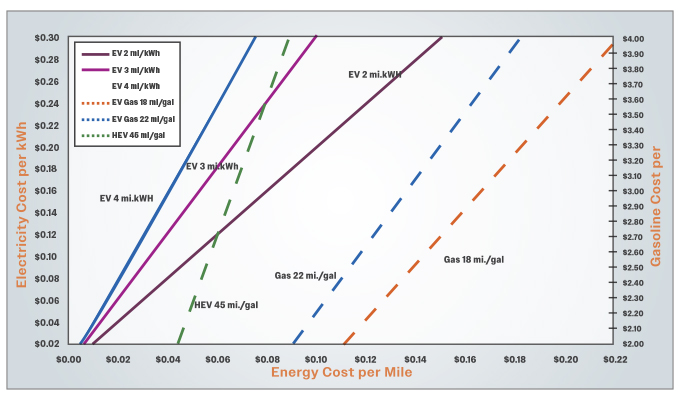Battery charging for electric vehicles remains difficult due to the high electricity costs—and EV operators are frustrated by inconsistent pricing practices, frequently broken equipment, and the lack of chargers available in strategic locations. Charging can be a frustrating experience, especially in states with steadily rising electricity rates due to inflation and intermittent renewable energy sources.
The permitting and construction process of implementing chargers can take 18 months or even longer, which results in lower production and difficult access to them—making it more challenging for fleet operators and businesses that are trying to “go green” in their operations. Fortunately, advanced data and sophisticated AI-powered connected telematics are now in place to help fleet operators identify the most optimum time to plug-in.
PROBLEMATIC COSTS
Aside from all the challenges with infrastructure, the energy costs alone can be severely problematic for fleets, further driving the need for this advanced connected vehicle data and insights. The cost of energy for an EV is equated to the cost of electricity per kilowatt-hour (kWh) and the energy efficiency of the vehicle.
In the example from the Advanced Vehicles and Infrastructure team at the Idaho National Laboratory (2017), to determine the energy cost per mile of an EV, select the location on the left axis (Electricity Cost per kWh) at 10 cents. Draw a horizontal line to the right until you bisect the EV 3 mi/kWh line. Now draw a vertical line down until you bisect the bottom axis (Energy Cost per Mile). This tells you that the fuel for an EV with an energy efficiency of 3 miles per kWh costs about 3.3 cents per mile when electricity costs 10 cents per kWh.

It is important to note that electricity costs in the US is about 10 cents per kWh. Charge rates for EVs in select areas may vary by time of use, day, and season. In the past, these rates ranged from 3 cents to as high as 50 cents per kWh. Older EVs can also have varying levels of electricity usage, as well as different vehicle brands.
To determine the energy cost per mile of a gasoline vehicle, pick the location on the right axis (Gasoline Cost per gallon) at $3.50. Draw a horizontal line to the left until you bisect the Gas 22 mi/gal line. Now draw a vertical line down until you bisect the bottom axis (Energy Cost per Mile). This tells you that the fuel for a gasoline vehicle with an energy efficiency of 22 miles per gallon costs about 15.9 cents per mile when gasoline costs $3.50 per gallon. The mileage for commercial fleets such as light-duty pickups range from below 17 miles per gallon to generally about 22 miles per gallon.
REPLACING GAS TAX USAGE
In addition to the costs associated with charging, many states are boasting that they are welcoming the movement to EVs, but others are considering new regulations that will make it more expensive and complicated for businesses to offer charging to the public.
Under these new rules, fleets that install a publicly available EV charger will have to quantify the amount of electricity dispensed from the charger—even if it has no separate meter—and pay a monthly usage tax to the state. This could be challenging for fleets that are looking to adopt more sustainable technology and reduce their carbon footprint. The new tax may make it costly to plug-in, and the additional tax may force businesses to pass those costs onto users—further complicating the already varying charging costs throughout the day.
AI + DATA HELP COSTS
Despite all of this, leading AI and data technology are offering intelligent solutions that can reduce the headaches and costs associated with driving and charging an EV. Today’s leading EV charge data solutions for fleets and vehicles leverage an Augmented Deep Learning Platform (ADLP), the industry’s first AI-driven augmented deep learning connected vehicle data platform, that leverages machine learning and data science with unique indicators that allow predictive real-time data insights to OEMs. This enhances the truck’s performance, quality, and driver experience.
ADLP collects and homogenizes vehicle data from millions of vehicles and enriches it with augmented data to generate deep, contextual insights so fleets can make smarter decisions for their businesses. The platform connects and analyzes everything in real-time—charge stations, optimized energy outputs at locations and time of day, cost savings, and congestion reduction rates. It can even predict failure cycles that holistically feeds data into smart city data infrastructure platforms. This will become critically important as more cities begin to tie intelligent data solutions across several aspects of the infrastructure. For example, the data can analyze or predict the best time of day to travel, which roads may increase vehicle damage risks, or the best time of day to plug-in and recharge.
This AI-driven connected vehicle data helps fleets make a seamless, successful transition to a greener, cleaner, and more sustainable future. EVs can be charged with accurate energy cost and rate plan selections. Intelligent energy consumption means it will lower the impact on the energy bill by charging EVs at the most optimal time. Lastly, they can leverage the power of smart cities by receiving notifications for the nearest charging station, reserving charging slots in the near future.
With these AI and data strategies available, fleets with EVs will have a better experience in adopting a greener solution for their operations while better controlling the cost of charging.
FOR MORE INFORMATION
Sumit Chauhan is the co-founder and chief operating officer of Cerebrum X, with more than 24 years of experience in automotive, IoT, and more. Chauhan has played the leadership role that allows him to manage a P&L across various organizations. He has applied his experience in the connected vehicle data domain to deliver the automotive industry an AI-powered augmented deep learning platform (ADLP). For more information, visit www.cerebrumx.ai.




